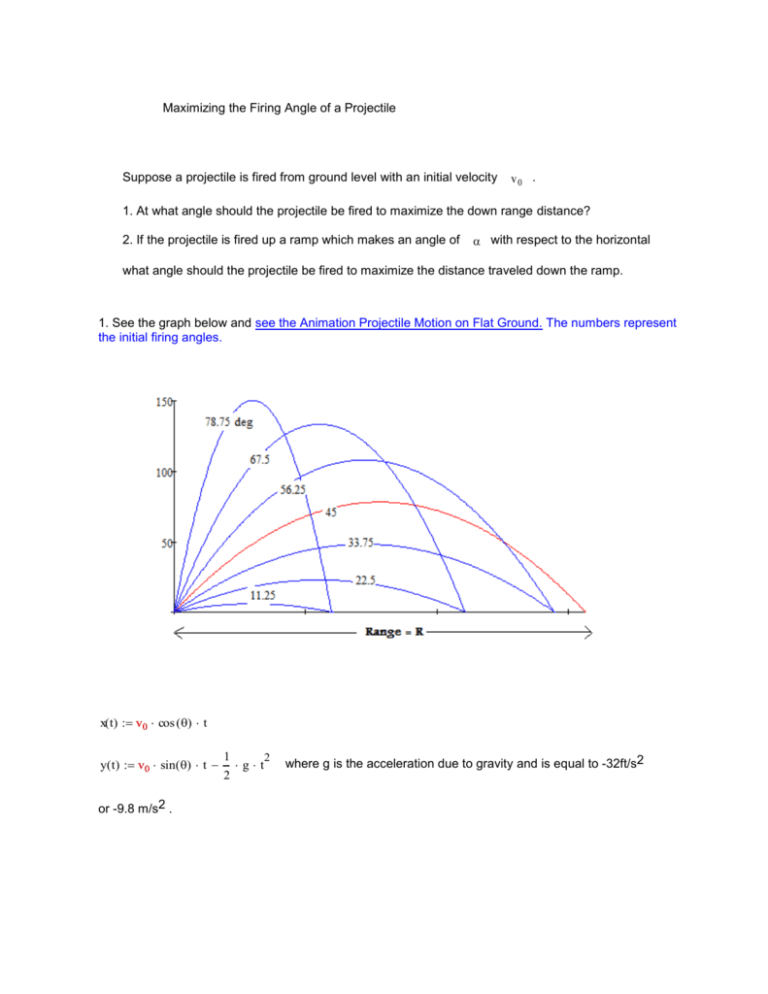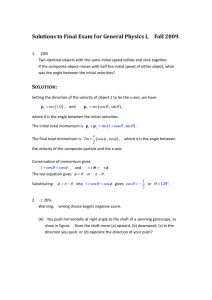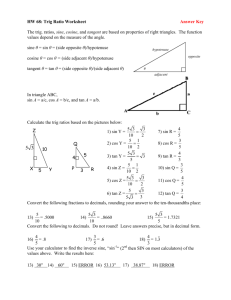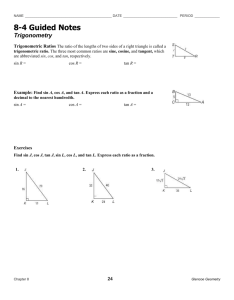Maximizing the Firing Angle of a Projectile Suppose a projectile is
advertisement

Maximizing the Firing Angle of a Projectile Suppose a projectile is fired from ground level with an initial velocity v0 . 1. At what angle should the projectile be fired to maximize the down range distance? 2. If the projectile is fired up a ramp which makes an angle of with respect to the horizontal what angle should the projectile be fired to maximize the distance traveled down the ramp. 1. See the graph below and see the Animation Projectile Motion on Flat Ground. The numbers represent the initial firing angles. x( t) v0 cos ( ) t y( t) v0 sin( ) t or -9.8 m/s2 . 1 2 gt 2 where g is the acceleration due to gravity and is equal to -32ft/s2 Step 1 We start by eliminating t between the 2 equations to get y as a function of x. In the first equation we get t x v 0 cos ( ) . We substitute this into the second equation: y x v0 sin( ) v0 cos ( ) 1 2 g x v cos ( ) 0 2 2 tan ( ) x gx 2 2 2 v0 cos ( ) Step 2 For a given initial angle θ we can obtain the Range R by setting y = 0 and solving for x: 2 0 gx tan ( ) x 2 2 2 v0 cos ( ) 2 gx 2 2 2 v 0 cos ( ) tan ( ) x gx 2 tan ( ) 2 2 v 0 cos ( ) tan ( ) 2 v0 cos ( ) v0 g g 2 x 2 2 2 sin( ) cos ( ) 2 2 cos ( ) v0 g 2 2 sin( ) cos ( ) v0 g sin( 2) 2 We obtain R v0 g sin( 2) . Step 3 To maximize the range with respect to the firing angle θ we differentiate R with respect to θ and set this equal to 0. 2 dR v0 d g 2 cos ( 2) 2 v0 g 2 cos ( 2) 0 therefore 2 2 from which we obtain 4 or 45 degrees. Suppose now we fire the projectile up a ramp which makes an angle α with respect to the horizontal. 1. See the graph below and see the Animation Projectile Motion on a Ramp. The numbers represent the initial firing angles. Step 1 is the same so we still have: 2 y gx tan ( ) x 2 2 2 v 0 cos ( ) Step 2 If α is the angle of the ramp the equation is y m x where m tan () . Here to find an expression for the range we set the equation of the projectile equal to the equation of the ramp: 2 m x gx tan ( ) x 2 2 2 v 0 cos ( ) m tan ( ) gx 2 2 2 v 0 cos ( ) 2 x 2 tan ( ) cos ( ) 2 m cos ( ) v0 2 g 2 Or v0 R g 2 sin( 2) 2 m cos ( ) 2 Step 3 Again we differentiate R and set it equal to 0: 2 dR v0 d g 2 [ ( 2 cos ( 2) ) 4 m cos ( ) sin( ) ] 2 cos (2 ) 2 m sin(2 ) g ( 2 cos ( 2 ) 2 m sin( 2 ) ) 0 1 tan ( 2) 2 v0 m tan 1 1 m This would yield a negative angle so we'll use the second quadrant angle with related angle 1/m to obtain: 2 tan 2 1 2 1 1 m tan 1 1 1 1 1 m or in degrees 90 - 2 tan m Note as m goes to 0 (flat ground scenario) we obtain 2 previous result. 1 2 2 4 which matches our In the graph below we use an angle α = 14.036 deg so m = 1/4 Then the max firing angle is 90 - atan ( 4) = 90 – 38 =52 (rounded to nearest 2 degree.) (To 3 decimal places 52.018 degrees) 37.982deg You may want to view the animation again.






